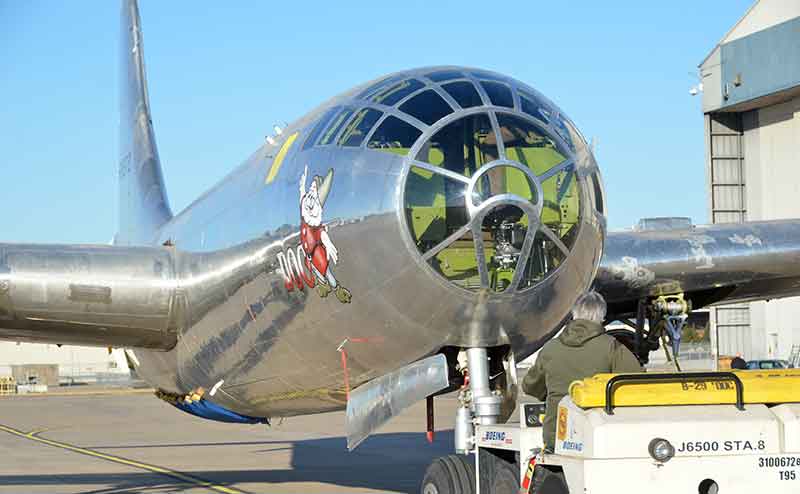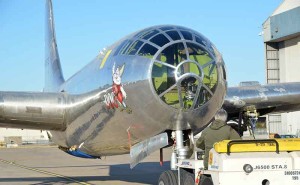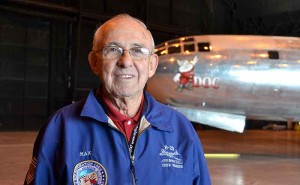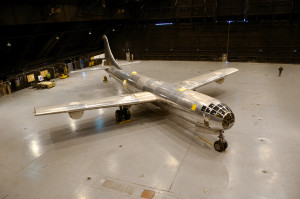Doc Restoration to Resume

 It’s been nearly three years since volunteers last turned the wrenches on the restoration work for the B-29 Superfortress known as Doc. This month, restoration on the 68-year-old piece of history will resume.
It’s been nearly three years since volunteers last turned the wrenches on the restoration work for the B-29 Superfortress known as Doc. This month, restoration on the 68-year-old piece of history will resume.
“We are tickled to death to be able to get back to work on it and finish it to flying status,” said Max Parkhurst, a B-29 Doc restoration volunteer. “It was first built in Wichita, we’re going to restore it here and we’re going to fly it out of here.”
In May of 2000, Doc was brought to Wichita where volunteers began work to restore the plane. After a slow 10-year process, restoration work was halted. Since 2010, the partially restored aircraft has been in storage.
Last month, Doc’s unmistakable aluminum skin glistened in the bright sunlight as volunteers gathered to watch the historic aircraft be towed into the Northwest Hangar at Boeing, where Parkhurst said restoration will soon resume.
 “We’ve got all of our equipment to move back into place, and before long we’ll be able to start working on it again. We’ll get the wings on, the nacelles on, and it’ll start looking like a real airplane again.”
“We’ve got all of our equipment to move back into place, and before long we’ll be able to start working on it again. We’ll get the wings on, the nacelles on, and it’ll start looking like a real airplane again.”
Parts needed for the restoration have been stored for several years in Newton, Kan. Parkhurst said the onboard wings are finished and those will be among the first of the larger parts that will be moved to Wichita from Newton.
Volunteers hope to have the plane restored and airworthy again within the next two years.
Doc was one of 1,644 B-29 Superfortress bombers built at Boeing Wichita’s Plant II. At the height of production in 1944, there were more than 29,000 Boeing Wichita employees and about 45 percent were women. Those employees rolled out three and a half B-29s every day from a plant that operated around the clock.
Doc rolled off the final assembly line in 1944 and was delivered to the United State Army Air Forces in March of 1945. The bomber’s career included overseas missions and a stint as a member of a radar calibration squadron in New York. The B-29 was one of a squadron of eight bombers named for Snow White and the Seven Dwarfs that were used for radar calibration in New York.
In 1956, Doc was decommissioned from the radar squadron and used as a target at the China Lake Naval Warfare Weapons Center in California’s Mojave Desert. After being shot at multiple times and surviving, Doc was moved to a remote area of the Naval base and spent 42 years sitting in the desert—baking in the sun and serving as a sanctuary for birds and other desert creatures.
 Doc was rescued in 1987 by a group of historians with a dream. The group, led by Tony Mazzolini and backed by the United States Aviation Museum, had a plan to restore the B-29 and eventually get it back into the air.
Doc was rescued in 1987 by a group of historians with a dream. The group, led by Tony Mazzolini and backed by the United States Aviation Museum, had a plan to restore the B-29 and eventually get it back into the air.
Parkhurst knows even though a lot of work has been done on the restoration, there’s still a lot more to do.
“We do see the light at the end of the tunnel now,” Parkhurst said.
“It’s been kind of long process, but we’re getting to the point where we’re going to be able to finish the airplane and get it back into the air. I’ve never flown in a B-29, but when we’re finished I plan to have some right-seat time.”


